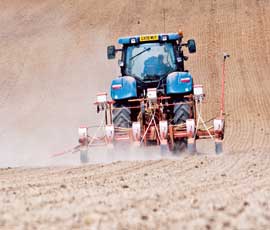Treated seed needs extra care in handling

Extra care is needed when handling treated seed to avoid the future loss of these valuable pesticides. Philip Case reports
Seed treatments offer the best environmental approach to crop protection, but unless the industry takes stewardship more seriously products could lose their approval, warn experts.
Compared with spraying a whole field, seed treatments use less chemicals and treat a much smaller part of the soil, says James Wallace, director of Dalton Seeds. “It offers a targeted approach in the seedling rather than spraying agrochemicals.”
However, recent articles in the press – fuelled by campaign groups calling for the removal of certain insecticide seed treatments amid claims they are a factor behind the decline in the bee population – have put them under the spotlight.
“We have bee issues, but we also have the increasing challenge of the perception of seed treatments around the safety of birds and small mammals, such as rats and mice,” says Adrian Cottey, Bayer CropScience campaign manager for seed treatments.
Achieving registrations for new products and active ingredients is harder than ever and existing products are being reviewed, he adds.
“Our first priority is defence. Prothioconazole, clothianidin, imidacloprid – we have seen the importance of some of these actives and we must keep hold of them.”
Treated seed protects plants, controlling pests such as flea beetle, which potentially can wipe out whole crops of oilseed rape.
But although they may officially be called “seed treatments”, they still contain agrochemicals, Mr Cottey stresses. And that means growers and contractors must make sure they are used safely and correctly.
Minimising dust and ensuring no seed is left on the soil surface, preventing access by wildlife, are the key points to remember.
First, Mr Cottey points to ensuring growers prepare good seed-beds appropriate for their drill. “To avoid leaving seed on the surface when drilling, before you start, check the drill and cultivators are set up correctly to maximise seed burial,” he says.
“When using cereal drills, sow the main body of the field first and the headlands last to help with coverage of row ends.”
Take care when drilling difficult and uneven cultivations, especially cobbly areas of fields, headlands and corners, which can force the coulters out of the soil and not cover seed adequately, he says. Also, treated seed should never be broadcast or Autocast.
To avoid seed spillage, take time and care when loading or emptying drills and when calibrating, he says. “Load drills in field areas to be drilled or in the yard where spillages can easily be collected.”
Small spillages can be buried in-field, but large spillages and any outside the field should be collected immediately and stored in original bags to await disposal.
Waste seed bags must be disposed of carefully and not left in fields where animals can rummage.
To reduce the risk of dust emission from seed, ensure precision vacuum drills vent safely downwards. “This will minimise emission of abraded seed treatment particles from drills.”
Masstock’s national seed manager, Richard Lawrence, adds that tipping seed into the drill from a height can abrade the seed and create extra dust.
“Dust is an issue in Germany and France and we must make sure it doesn’t become one here.”
Quality asssured
An industry-led quality assurance system for seed treatment and treated seed, the European Seed Treatment Assurance (ESTA) scheme, is currently being developed by the seed industry, together with crop protection and seed treatment companies.
The aim is to assure that the market for treated seed is in line with the provision of the pesticides and seed marketing legislation.
Maize and oilseed rape crops will be the first to be monitored under the scheme, which is expected to be rolled out this July.

